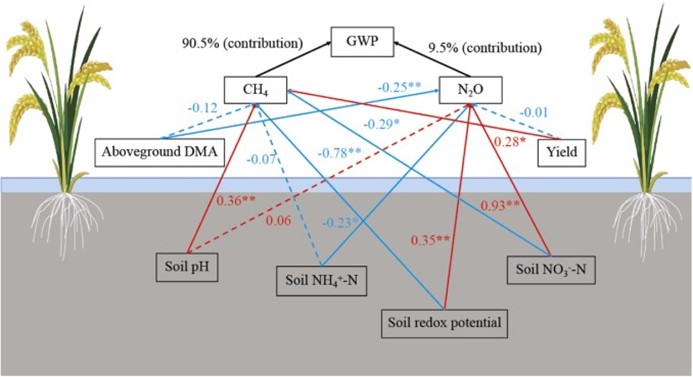July 1, 2024 | Agricultural Water Management | Source |
Introduction: Alternate wetting and drying (AWD) is a widely adopted water-saving irrigation technique in Asian rice-producing countries that is effective in reducing CHâ‚„ emissions while maintaining crop yields. However, long-term AWD can increase Nâ‚‚O emissions, nitrogen and soil organic carbon (SOC) losses, and affect soil carbon sequestration and GHG emissions. Biochar, recognized as a negative emission technology and an effective use of straw resources, has the potential to increase soil carbon storage, improve grain yields, and suppress GHG emissions over time. However, biochar's aging effects on soil properties, GHG emissions, and crop yields remain understudied. How biochar converts rice fields to carbon negative and investigating net global warming potential (GWP) based on soil carbon sequestration is still limited, especially under AWD systems. To address this gap, researchers from Shenyang Agricultural University, China, conducted a three-year field study using a split-plot design to evaluate the effects of biochar on CHâ‚„ and Nâ‚‚O emissions, soil carbon sequestration, net GWP, and rice yield under AWD and continuous flooding (CF) irrigation.
Key findings: A three-year field experiment in Shenyang, China, used a split-plot design with CF and AWD irrigation, with biochar applied at 0 and 20 t/ha. CHâ‚„ and Nâ‚‚O emissions were measured using an opaque static chamber method and gas chromatography. SOC, nitrogen, soil pH, redox potential and rice yield were analyzed using potassium dichromate digestion, KCl extraction and automated analyzers.
This study demonstrated that integrating biochar with AWD significantly improved soil carbon sequestration and reduced GHG emissions. AWD irrigation significantly reduced CHâ‚„ emissions by 63-79% over three years compared to CF. However, AWD increased Nâ‚‚O emissions by 100-123%. The addition of biochar (20 t/ha) reduced CHâ‚„ emissions by 22% in the second year and 38% in the third year, while mitigating AWD-induced Nâ‚‚O emissions by 28-33%. Biochar also improved soil carbon sequestration , particularly under AWD, resulting in the highest soil carbon sequestration (56.9 t C/ha) and lowest net GWP of -23.0 t COâ‚‚-eq/ha. Grain yield was unaffected in the first year but increased by 5-11% in subsequent years with biochar application. The effects of biochar on soil properties (e.g. pH and redox potential) improved conditions for CHâ‚„ oxidation and suppressed Nâ‚‚O emissions over time. Therefore, despite increased Nâ‚‚O emissions under AWD, biochar effectively reduced GWP and GHGI by an average of 74%. Overall, compared to CF without biochar, biochar application in CF and AWD reduced net GWP by four and eight times, respectively, due to increased soil carbon. AWD with biochar achieved further reductions in GWP compared to CF with biochar. The results suggest that combining biochar with AWD offers a sustainable strategy for mitigating GHG emissions, enhancing carbon sequestration and achieving carbon-negative rice production. This approach supports climate-smart agricultural practices, especially in water-scarce regions; while further research is recommended to explore long-term impacts and wider applications.

Figure | Path analysis of CH4 and N2O emissions and soil environmental factors. Red arrows indicate positive impacts, blue arrows represent negative impacts, solid lines effect significantly and dotted lines effect insignificantly. Black arrows indicate contribution value of CH4 and N2O emissions to GWP. **: P < 0.01; *: P < 0.05; ns: no significant. Values indicate the strength of the relationship between the two variables.





